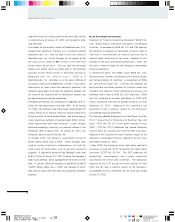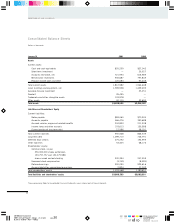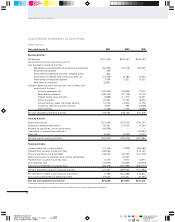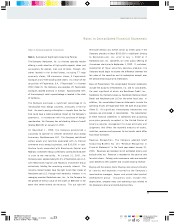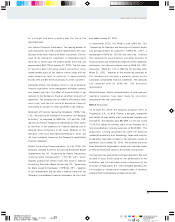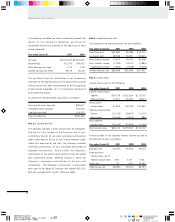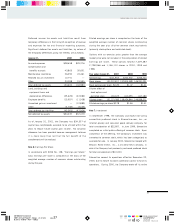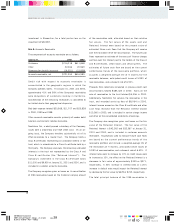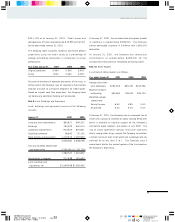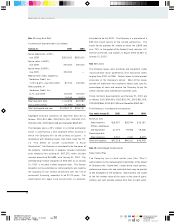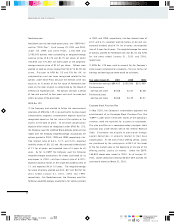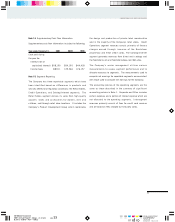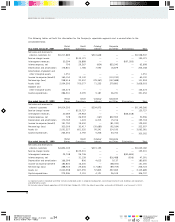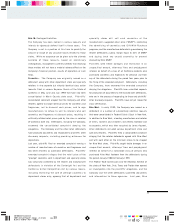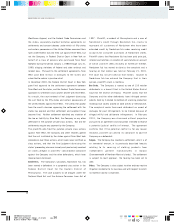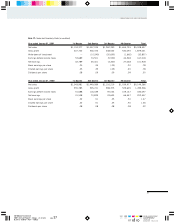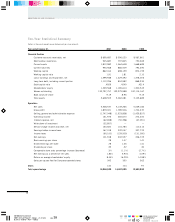Nordstrom 2000 Annual Report Download - page 30
Download and view the complete annual report
Please find page 30 of the 2000 Nordstrom annual report below. You can navigate through the pages in the report by either clicking on the pages listed below, or by using the keyword search tool below to find specific information within the annual report.
Cyan Mag Yelo Blk
20100444 Nordstrom
2001 Annual Report • 44pgs. + 4 covers pg. 28
8.375 x 10.875 • PDF • 150 lpi
PMS
5773
PMS
5503
28
NORDSTROM, INC. AND SUBSIDIARIES
investment in Streamline, for a total pre-tax loss on the
investment of $32,857.
Note 8:Accounts Receivable
The components of accounts receivable are as follows:
January 31, 2001 2000
Customers $716,218 $611,858
Other 22,266 20,969
Allowance for doubtful accounts (16,531) (15,838)
Accounts receivable, net $721,953 $616,989
Credit risk with respect to accounts receivable is
concentrated in the geographic regions in which the
Company operates stores. At January 31, 2001 and 2000,
approximately 41% and 38% of the Company’s receivables
were obligations of customers residing in California.
Concentration of the remaining receivables is considered to
be limited due to their geographical dispersion.
Bad debt expense totaled $20,368, $11,707 and $23,828
in 2000, 1999 and 1998.
Other accounts receivable consists primarily of vendor debit
balances and cosmetic rebates receivable.
Nordstrom fsb, a wholly-owned subsidiary of the Company,
issues both a proprietary and VISA credit card. On an on-
going basis, the Company transfers substantially all of its
VISA receivables to a master trust. The Company holds a
Class B certificate, representing an undivided interest in the
trust, which is subordinate to a Class A certificate held by a
third party. The Company also owns the remaining undivided
interests in the trust not represented by the Class A and
Class B certificates (the “Retained Interest”). The
Company’s investment in the Class B certificate totals
$11,000 and $9,900 at January 31, 2001 and 2000, and is
included in customer accounts receivable.
The Company recognizes gains or losses on its securitization
of VISA receivables based on the historical carrying amount
of the receivables sold, allocated based on their relative
fair values. The fair values of the assets sold and
Retained Interest were based on the present value of
estimated future cash flows that the Company will receive
over the estimated life of the securitization. The future cash
flows represent an estimate of the excess of finance charges
and fees over the interest paid to the holders of the Class A
and B certificates, credit losses and servicing fees. The
estimates of future cash flow are based on the current
performance trends of the receivable portfolio, which
assumes a weighted-average life of 5 months for the
receivable balances, anticipated credit losses of 5.99% of
new receivables, and a discount rate of 6.50%.
Proceeds from collections reinvested in previous credit card
securitizations totaled $485,422 in 2000. Gains on the
sale of receivables to the trust totaled $5,356 in 2000.
Additionally, Nordstrom fsb services the receivables in the
trust, and recorded servicing fees of $8,564 in 2000.
Interest income earned on the Class B certificate and other
cash flows received from the Retained Interest totaled
$10,060 in 2000, and is included in service charge income
and other on the consolidated statements of earnings.
The Company also recognizes gains and losses on the fair
value of the Retained Interest. The fair value of the
Retained Interest is $42,052 and $32,567 at January 31,
2001 and 2000, and is included in customer accounts
receivable. Assumptions used to measure future cash flows
are based on the current performance trends of the
receivable portfolio and include a weighted-average life of
the receivables of 5 months, anticipated credit losses of
5.99% of new receivables, and a discount rate of 6.50%. If
interest rates were to increase by 10% or credit losses were
to increase by 10%, the effect on the Retained Interest is a
decrease in fair value of approximately $339 or $371,
respectively. A 20% increase in interest rates or a 20%
increase in default rates would impact the Retained Interest
by decreasing the fair value by $678 or $743, respectively.
The total principal balance of the VISA receivables is


